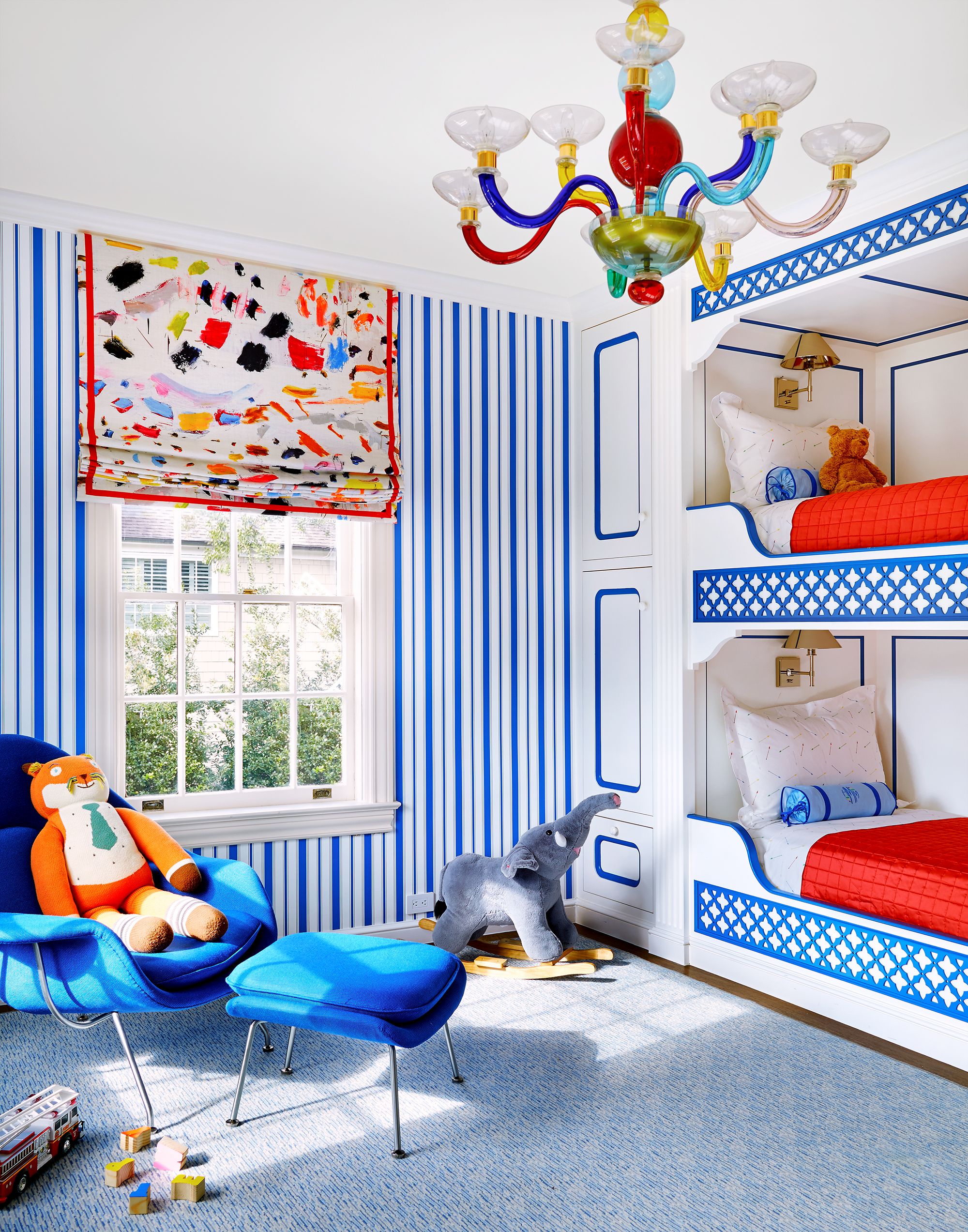Sharing a bedroom with your child or children may be enjoyable, but it can be tough to plan the space. If you have a set of identical twins or two children of different ages who get along fantastically, they may need to share a room. It takes skill to divide a shared bedroom so that each child feels comfortable while still enjoying the overall space. The quantity of space that will be shared is the first factor to consider when setting up a roommate arrangement. If you don’t have a designated playroom, a spare bedroom can suffice. If your bedroom is small, however, loft beds are the way to go since they free up important floor space that can be utilized for other purposes, such as playing or completing schoolwork. The second concern is how to partition a huge bedroom into smaller sleeping spaces, which again relies around furniture placement and wall placement. See a variety of ideas for decorating a kid-friendly shared bedroom below.
Symmetry
If your bedroom is small, try to make the most of the space by arranging your furniture in a symmetrical pattern. We have a pair of identical twin beds that divide one wall of the room in half. A dresser in the center acts as a nightstand and has enough of storage for your belongings.
Back to back
When siblings don’t always get along, putting restrictions can help make things better. These are twin beds separated by a small partition. They won’t have to worry about colliding because they’ll be sporting separate headlights. Because of the drawers, the children may quickly establish a common location to play and connect.
Separation
When your children share a small bedroom, it’s especially crucial to preserve the peace if they have a history of arguing. If the room can be divided into two sections, the children may play without bothering each other’s belongings. Convergence on a format is required for the design process to continue.
Utilize Storage
Sharing a bedroom is already challenging. This bed frame contains storage drawers to help you make the most of your limited space. Using this bunk bed might help you save crucial square footage. As an extra advantage, the pullout bins make the area under the bed easily accessible, and the beds may be stacked to produce more floor space.
Platforms
A nice bedroom for two may be created even in the most improbable of places, such as a stairwell landing. This is a terrific alternative to a trundle bed for really close siblings since one youngster may sleep directly over the other. enclosed area? Yes. An incredibly contemporary design for a multi-person room? Absolutely.
Light Hues
Decorate with bright and breezy colors to make a small place feel larger. This once-dark attic was brightened with a few coats of white paint. With the bright bedding and carpeting, this little room transforms into a delightful play place for children.
For the twins
One of the most important design elements in a small bedroom is uniformity. Give each youngster an equal amount of room and a specific location for their possessions. To guarantee that everything fits, choose furniture with a number of cubbies that is divisible by two. Also, twin beds may be more handy in your guest room than a king-size bed. Because some guests may feel uneasy sharing a bedroom with a complete stranger, this arrangement avoids the need for anybody to sleep on the sofa. You’ll have enough of space to work comfortably if you place your desk in the center of the room.
Oceanic
Despite its small size, the guest room at the beach house exudes grandeur because to its well chosen color scheme. Bright, airy colors should be used to adorn guest rooms. The neutral colors are soothing, and the large number of windows ensures that visitors wake up feeling rejuvenated.
Bunk Beds
Bunk beds integrated into the wall of a room can make good use of limited space. This wall-mounted design features a double deck and a window seat. Built-ins may appear to be a major renovation project, but the end result is elegant and efficient storage that will endure for years.
Rearranging
If your children share a room, think about how you might split the space so that they each have their own bed. If you don’t want to use bunk beds, you may make nook beds for each child using canopy curtains, a drape draped from the ceiling, or a shallow stud wall. Dressing the beds with the same colors but different patterns is another way to make the room look different and meet each child’s needs. The children each have their own playroom, where they may stretch out and make use of the floor and table space for their many games and activities. Children who like playing with train lines may benefit from more open floor space, whereas children who are creative or who lack adequate storage space will benefit from more tabletop space. A climbing wall with soft flooring underneath is the best play for energetic kids, inspirebyblog and bunk beds are wonderful as long as there is a secure slide for quick exits.
Make it Playful
Designing a tween’s or child’s bedroom may be divided into two different but equally significant tasks: decorating for flair and decorating for play. There are many different ways to decorate, such as murals, blackboard paint for drawing, funny wallpaper patterns, and originals made by guests. To get the most out of your fun and leisure time, decorate with calming hues such as blues, greens, and pastels. A dog in the room might be a terrific way to give extra entertainment for the youngsters. Provide a separate area for the dog so that they may spend more time with their canine buddy. Adding facts that are important to your child is a great way to show that you’ve taken the time to learn about and respect the things that are important to them.
It is common known that today’s children desire to accompany their pets on family trips. Check out Slingo.com for vacation ideas to take your kids and man’s best friend.
Let’s discuss about kids’ playrooms, where making the most of every inch of floor and tabletop space is crucial for fitting everyone’s favorite activities. More floor space is ideal for children who enjoy playing trains, and more desk space is ideal for children who are creative or whose rooms lack adequate storage. A climbing wall with soft flooring beneath is the best toy for kids who need to get some exercise, and bunk beds are wonderful if there is a secure slide for quick exits.
In summary, Sharing a bedroom with a child or children can be challenging, so it is important to consider the quantity of space, furniture placement and wall placement, symmetry, separation, and utilization of storage to create a kid-friendly space. The most important design elements in a small bedroom are uniformity, light hues, bunk beds, nook beds, and neutral colors. Making the most of every inch of floor and tabletop space is essential for fitting everyone’s favorite activities, such as trains, desk space, climbing walls, and bunk beds.




